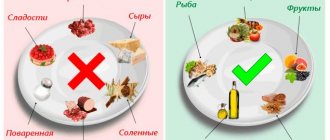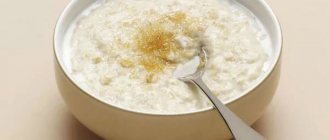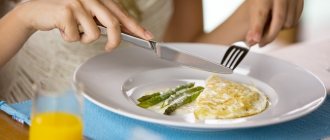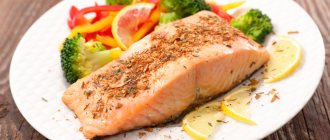Example menu
The first day:
- First breakfast: freshly squeezed juice, a portion of oatmeal with water, 1 boiled egg, cabbage, cucumber and red pepper salad.
- Second breakfast: grated carrots with honey.
- Lunch: pasta made from durum wheat flour, beet salad with nuts.
- Afternoon snack: 35 g almonds, a glass of blueberries.
- Dinner: seafood soup, vegetable stew.
- Second dinner: 250 ml of kefir 0–1% fat.
Second day:
- First breakfast: weak green tea without sugar with lemon and honey, buckwheat porridge with bell pepper, dill and broccoli.
- Second breakfast: several fresh apples.
- Lunch: vegetarian borscht, a piece of black bread, dried fruit compote.
- Afternoon snack: 150 g of cottage cheese with the addition of dried apricots.
- Dinner: 120 g of steamed fish, a side dish of boiled vegetables with vegetable oil.
- Second dinner: yogurt with berries.
Day three:
- First breakfast: fresh juice, buckwheat porridge, vinaigrette, rose hip decoction.
- Second breakfast: salad of cabbage, apples, cucumbers and carrots, seasoned with vegetable oil.
- Lunch: a cup of vegetable soup, 130 g of fruit jelly.
- Afternoon snack: a bunch of grapes.
- Dinner: boiled fish with mashed potatoes and vegetable oil.
- Second dinner: yogurt.
Day four:
- First breakfast: fruit salad.
- Second breakfast: milkshake with banana.
- Lunch: beetroot soup, baked potatoes, tomato juice.
- Afternoon snack: baked apples, uzvar.
- Dinner: barley porridge with seaweed.
- Second dinner: yogurt.
Day five:
- First breakfast: oatmeal with berries, hawthorn tea.
- Second breakfast: salad of fresh tomatoes and cucumbers with herbs, dressed with vegetable oil.
- Lunch: potato and carrot puree soup with sour cream.
- Afternoon snack: sandwich with fresh tomato and canned salmon.
- Dinner: corn porridge with fish cutlet, stewed cabbage with prunes.
- Second dinner: yogurt.
Day six:
- First breakfast: two-white omelette with herbs, chicory with the addition of skim milk.
- Second breakfast: carrot and beet salad, cottage cheese casserole.
- Lunch: seafood soup.
- Afternoon snack: apple with cinnamon and cottage cheese, baked in the oven.
- Dinner: steamed fish cutlets, mashed potatoes.
- Second dinner: salad of grated carrots and apples.
Day seven:
- First breakfast: a couple of oatmeal pancakes with a spoon of honey, an orange.
- Second breakfast: tea with a handful of dates.
- Lunch: A bowl of soup with turkey meatballs.
- Afternoon snack: a few slices of melon.
- Dinner: salad of lettuce, tomatoes and boiled shrimp.
- Second dinner: weak green tea and some dried fruits.
What can you eat
When limiting a patient with ischemia in certain foods, it is worth remembering the need to maintain normal metabolic processes in the body. In particular, we must not forget about the activity of the central nervous system and the alignment of lipid metabolism. Vegetable fats must be present in the diet to reduce blood clotting.
In the absence of pathologies of the stomach and intestines, the diet should be strengthened with fresh vegetables and fruits; in case of disturbances, vegetables should be steamed and mashed. Vitamin B6, which is found in abundance in soy products (noodles, tofu), bran baked goods, rye flour, mussels, shrimp, seaweed, and many varieties of sea fish, is actively involved in the utilization of excess cholesterol and the removal of “bad fats.” You should also pay attention to low-fat fermented milk products - yoghurt, kefir, fermented baked milk, cottage cheese.
The basis of the diet should be:
- oatmeal, buckwheat porridge;
- greens, vegetables (excluding spicy, highly sour) fresh and steamed;
- crackers, bread, bran baked goods;
- soups prepared with vegetable broths or boneless meat;
- milk soups;
- boiled or baked veal, chicken, turkey, fish;
- seafood - squid, mussels, seaweed, krill, shrimp;
- low-fat varieties of sausage, ham (boiled only, not smoked);
- dairy, lactic acid products;
- vegetable oil.
You can eat 3 eggs (preferably soft-boiled) or 5-6 whites per week.
Nutritional Features
Products for cardiac ischemia should contain increased amounts of vitamin C. It prevents vasoconstriction, has a relaxing effect on the arteries, reducing pressure, and also reduces the permeability of blood vessels.
In addition, it is a powerful antioxidant. The menu includes foods rich in potassium, magnesium, iodine, manganese and zinc. The body also needs methionine, an essential amino acid that is part of proteins, and B vitamins. The introduction of seafood, rich in cholesterol that is beneficial for the human body, into the diet is also necessary.
Allowed foods
Nutrition for angina pectoris includes foods that do not contradict the listed general principles of a healthy diet. These include:
- porridge (wheat, buckwheat, millet, oatmeal, barley);
- dried fruits (dried apricots, raisins, prunes);
- fresh or baked fruits and vegetables;
- vegetable oils;
- fish, seaweed;
- dietary types of meat (game, chicken, turkey);
- dairy products;
- honey.
All of them are rich sources of microelements (phosphorus, calcium, magnesium, iron, potassium, sodium, zinc) and vitamins. In the human body, they normalize metabolism and establish its balance. If angina pectoris is diagnosed, then the diet includes more different leafy vegetables, for example, cabbage, parsley, spinach. You can remove excess cholesterol from the body by daily eating food with coarse fibers, which mechanically cleanse the intestines, slowing down the process of vascular damage. Water balance is achieved by drinking a couple of liters of water per day.
Product selection
The key point in the diet is the correct choice of foods, because some of them are prohibited, others are acceptable in small quantities, and others should prevail in the daily menu. Each option should be considered separately.
Prohibited
It is necessary to exclude those foods that increase cholesterol levels in the blood, impair blood circulation and promote the formation of blood clots, which impede blood flow and impair the nutrition of the heart muscle. These are:
- fatty meats, such as pork and lamb;
- fatty poultry - duck, goose;
- sausages;
- offal, including liver and brains;
- smoked meats;
- pickles;
- cream;
- fried eggs;
- flour and confectionery products;
- chocolate;
- ice cream;
- lemonade and sweet carbonated drinks;
- alcohol.
The listed products are also prohibited due to their high content of easily digestible carbohydrates, which are often the cause of obesity.
Limited
There are foods that can be consumed in limited quantities:
- Proper nutrition of a patient with heart failure and edema
- drinks with a high caffeine content (coffee, strong tea) - 1-2 cups per day, as they have a strong diuretic effect and remove a lot of fluid from the body;
- fatty fish (mackerel, trout, sardine), seafood – up to 3-4 times a week;
- meat (beef, veal, turkey, rabbit) – once a week;
- eggs, chicken - up to 2-3 times a week;
- salt - up to 5-6 g per day, since it prevents the removal of fluid from the body.
Any leafy green is worth using as a salt substitute as it contains vitamins A, B, C and PP, as well as many minerals, including folic acid, phosphorus, calcium, potassium and iron.
Recommended
The basis of the daily diet consists of products that meet the following criteria:
- contain minerals (phosphorus, calcium, magnesium, iron, potassium, sodium, zinc);
- are sources of vitamins A, B, C, E, PP;
Vitamin C is especially useful for angina, which is a strong antioxidant, prevents blood vessels from narrowing, reduces their permeability and has a relaxing effect on the arteries.
- rich in fiber and coarse fibers, which remove excess “bad” cholesterol from the body, cleanse the intestines, normalize metabolism, and slow down the process of vascular damage.
The following products meet these criteria:
- beans, bran and cereals (especially oatmeal, buckwheat, millet, barley);
- milk and fermented milk products are valuable sources of lactose, thiamine, vitamin A, calcium;
- vegetables, especially leafy vegetables (any cabbage, spinach);
- fruits, especially banana, as it is high in potassium;
- vegetable oils (sunflower, olive, corn) – sources of mono- and polyunsaturated fats, as well as vitamins A, D, E, K and F, involved in cell formation and metabolism;
- nuts (walnuts, almonds, hazelnuts);
- honey, since it is a valuable source of potassium and successfully replaces sugar;
- dried fruits (raisins, prunes, dried apricots).
It is worth noting that this set of products requires a therapeutic diet - table No. 10. It is anti-atherosclerotic and is prescribed to normalize metabolism, reduce blood clotting and restore the metabolism of blood vessels and heart muscle.
Fully or partially limited products
- Exclude products made from puff pastry, pastries, cakes, cream pies, confectionery (sweets, waffles, halva, chocolate), sugar, jam, ice cream, white rice, semolina.
- Highly extractive meat/fish/mushroom broths.
- Fatty meats, cooking fats, mayonnaise, margarine, kidneys, brains, liver, sausages, canned food and smoked meats.
- Fatty dairy products.
- Canned fish, caviar, smoked fish.
Limit egg yolks, strong tea and coffee, cocoa, grapes, honey, raisins.
Table of prohibited products
| Proteins, g | Fats, g | Carbohydrates, g | Calories, kcal | |
Vegetables and greens | ||||
| radish | 1,2 | 0,1 | 3,4 | 19 |
| white radish | 1,4 | 0,0 | 4,1 | 21 |
| red radish | 1,2 | 0,1 | 3,4 | 20 |
| black radish | 1,9 | 0,2 | 6,7 | 35 |
| spinach | 2,9 | 0,3 | 2,0 | 22 |
| sorrel | 1,5 | 0,3 | 2,9 | 19 |
Fruits | ||||
| bananas | 1,5 | 0,2 | 21,8 | 95 |
Berries | ||||
| grape | 0,6 | 0,2 | 16,8 | 65 |
Mushrooms | ||||
| mushrooms | 3,5 | 2,0 | 2,5 | 30 |
Nuts and dried fruits | ||||
| raisin | 2,9 | 0,6 | 66,0 | 264 |
Cereals and porridges | ||||
| semolina | 10,3 | 1,0 | 73,3 | 328 |
| rice | 6,7 | 0,7 | 78,9 | 344 |
Flour and pasta | ||||
| pasta | 10,4 | 1,1 | 69,7 | 337 |
Confectionery | ||||
| jam | 0,3 | 0,2 | 63,0 | 263 |
| jam | 0,3 | 0,1 | 56,0 | 238 |
| candies | 4,3 | 19,8 | 67,5 | 453 |
| pastry cream | 0,2 | 26,0 | 16,5 | 300 |
| cookie | 7,5 | 11,8 | 74,9 | 417 |
Ice cream | ||||
| ice cream | 3,7 | 6,9 | 22,1 | 189 |
Cakes | ||||
| cake | 4,4 | 23,4 | 45,2 | 407 |
Chocolate | ||||
| chocolate | 5,4 | 35,3 | 56,5 | 544 |
Raw materials and seasonings | ||||
| mustard | 5,7 | 6,4 | 22,0 | 162 |
| mayonnaise | 2,4 | 67,0 | 3,9 | 627 |
Dairy | ||||
| milk 3.6% | 2,8 | 3,6 | 4,7 | 62 |
| milk 4.5% | 3,1 | 4,5 | 4,7 | 72 |
| cream | 2,8 | 20,0 | 3,7 | 205 |
| sour cream 25% (classic) | 2,6 | 25,0 | 2,5 | 248 |
Cheeses and cottage cheese | ||||
| cheese | 24,1 | 29,5 | 0,3 | 363 |
| cottage cheese 11% | 16,0 | 11,0 | 1,0 | 170 |
| cottage cheese 18% (fat) | 14,0 | 18,0 | 2,8 | 232 |
Meat products | ||||
| pork | 16,0 | 21,6 | 0,0 | 259 |
| pork liver | 18,8 | 3,6 | 0,0 | 108 |
| pork kidneys | 13,0 | 3,1 | 0,0 | 80 |
| pork fat | 1,4 | 92,8 | 0,0 | 841 |
| salo | 2,4 | 89,0 | 0,0 | 797 |
| beef liver | 17,4 | 3,1 | 0,0 | 98 |
| beef kidneys | 12,5 | 1,8 | 0,0 | 66 |
| beef brains | 9,5 | 9,5 | 0,0 | 124 |
Sausages | ||||
| smoked sausage | 16,2 | 44,6 | 0,0 | 466 |
| smoked sausage | 9,9 | 63,2 | 0,3 | 608 |
| sausages | 10,1 | 31,6 | 1,9 | 332 |
| sausages | 12,3 | 25,3 | 0,0 | 277 |
Bird | ||||
| smoked chicken | 27,5 | 8,2 | 0,0 | 184 |
| duck | 16,5 | 61,2 | 0,0 | 346 |
| smoked duck | 19,0 | 28,4 | 0,0 | 337 |
| goose | 16,1 | 33,3 | 0,0 | 364 |
Fish and seafood | ||||
| smoked fish | 26,8 | 9,9 | 0,0 | 196 |
| salted fish | 19,2 | 2,0 | 0,0 | 190 |
| Red caviar | 32,0 | 15,0 | 0,0 | 263 |
| black caviar | 28,0 | 9,7 | 0,0 | 203 |
| canned fish | 17,5 | 2,0 | 0,0 | 88 |
| cod (liver in oil) | 4,2 | 65,7 | 1,2 | 613 |
Oils and fats | ||||
| animal fat | 0,0 | 99,7 | 0,0 | 897 |
| cooking fat | 0,0 | 99,7 | 0,0 | 897 |
Non-alcoholic drinks | ||||
| instant coffee dry | 15,0 | 3,5 | 0,0 | 94 |
| black tea | 20,0 | 5,1 | 6,9 | 152 |
| * data is per 100 g of product | ||||
The essence and rules of the diet
Angina pectoris is one of the manifestations of coronary heart disease that develops due to atherosclerosis. The disease occurs when fat metabolism is disrupted - the body receives a lot of fatty fats, which contribute to the formation of “bad” cholesterol, which is deposited on the walls of blood vessels in the form of atherosclerotic plaques. Thus, the lumen of blood vessels decreases, so the heart muscle receives insufficient oxygen, and chronic oxygen starvation gradually develops.
By correcting your diet, you can prevent the progression of angina pectoris. This requires compliance with the following rules:
- Diet for blood type 2 negative: food table and diet
- with a normal initial weight, reduce the daily calorie content to 2800-2900 kcal, and correctly distribute the chemical composition of the diet: proteins - up to 100 g, fats - up to 90 g, carbohydrates - up to 350 g;
- if you are overweight, reduce your daily caloric intake so that it does not exceed 2000 kcal, with the amount of fat per day up to 70 g, and carbohydrates up to 300 g;
- switch to fractional meals - in addition to the 3 main meals, you can have 1-2 snacks, and the diet should be varied, including products of predominantly plant origin;
- maintain the correct water regime - drink about 2 liters of liquid during the day;
- exclude fats of animal origin from the diet, with the exception of fatty sea fish and seafood, since they contain omega-3 acids, which have a positive effect on cholesterol metabolism;
- prepare food through proper heat treatment, such as stewing, boiling and steaming, but frying is not recommended.
By following these rules, you can get rid of extra pounds and maintain a healthy weight. This will improve metabolic processes in the body, avoid the development of complications of angina pectoris and maintain stable health.
Why is it important to adhere to therapeutic nutrition for heart disease?
One of the main goals of therapeutic nutrition is to enhance the effect of taking medications prescribed by a doctor. In some cases, with a properly selected diet, it is possible to do without medications altogether or significantly reduce their amount and period of use. For this reason alone, it is worth listening to the advice of an experienced nutritionist and switching to a therapeutic diet immediately after making the appropriate diagnosis.
A nutritionist will help develop a treatment menu and the required level of physical activity at which the load on the heart and blood vessels will be optimal. In addition, a nutrition consultant will tell you which habits you should give up right now.
These include smoking, drinking alcohol, overeating, abuse of simple carbohydrates, leading to obesity and insulin resistance ( diabetes mellitus
is an aggravating factor in cardiovascular diseases).
Another important task of diet therapy is the correction of metabolic disorders that inevitably arise with such diagnoses, relieving the heart from excessive stress, and improving the absorption of food through proper diet.
Thanks to a special diet, it will be possible to normalize weight, lower blood pressure, reduce lipid and blood sugar levels, and reduce the susceptibility to thrombosis. All this will certainly affect your well-being and general health, and will also significantly reduce the risk of developing serious cardiovascular pathologies and complications, disease progression and death.









